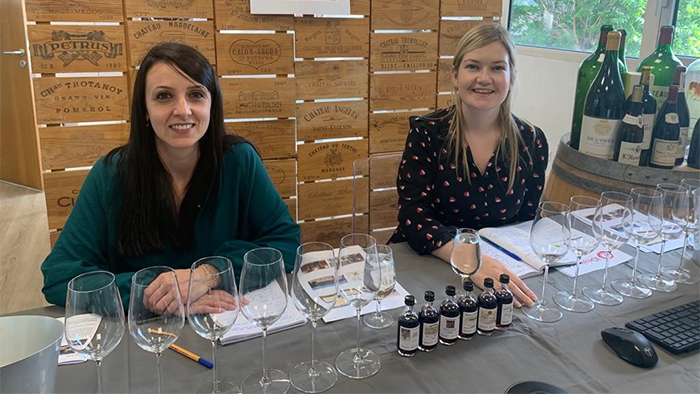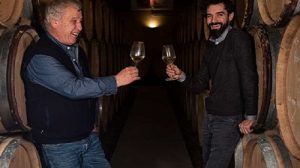
Wine tasting techniques explained: how do you taste wine? Once again, the iDealwine team has risen to the challenge, sharing a bottle and unravelling the secrets of wine tasting to bring you the answers to all your questions!
There are as many ways to taste wine as there are tasters. Venturing into this topic is like entering a vast, unknown – if not frightening – realm. Fear not as it’s far easier than it first seems. And if you enjoy the experience, you’re probably using the right method! Either way, you don’t need to be fluent in the entire sommelier lexicon to succeed in tasting wine correctly. Simply keeping a few key concepts in mind will help you decipher wine more effectively. And just like with any method, experience will pay off and enable you to shape your own approach.
Look
You can marvel at the bubbles in a Champagne glass or the rich colour of an old Sauternes. But forget about those stories of legs or tears. They’re hardly worth a mention! The truth is, the visual examination provides you with pretty limited insights. The colour of the wine may hint at its concentration level. Yet, there are many instances where this is not the case. Some grape varieties (such as Grenache) might exhibit limited colour intensity but produce considerably bold wines. It’s only in the context of a blind tasting that this step truly proves useful as it can offer insight into the wine’s age. Next, shift your attention from the colour to reflections.
In the case of a white wine, look at the reflections on the disc by positioning your eye level with the glass. With age, a white wine successively displays green reflections, then silver, gold and finally bronze. White with silvery reflections is likely to be a wine that is one or two years old.
When assessing a red wine, tilt your glass against a white background, and observe from the opposite side. Here, reflections range from cherry to raspberry tints, evolving towards tile-red.

Smell
There are two stages to analysing the nose. The first step consists in sniffing the wine when it’s still, in other words, without moving the glass, shortly after it has been poured. This first nose is usually not very powerful. This is actually the perfect time to spot faults in wine. With the aromas still subdued, flaws are pretty obvious. Such is the case of the infamous ‘cork taint’, particularly noticeable on the nose.
The second nose consists in sniffing the wine after swirling it slightly, by moving the glass in a circular motion. Aeration prompts a reaction in wine, which is a living organism, releasing heavier aromas. The absence of aromas could indicate that the wine requires more time to aerate (either in the bottle or a decanter). It’s worthwhile to explore the different scents by moving your nose around the glass too, uncovering hidden aromas. You might enjoy engaging in a game of ‘aroma recognition’ (we recommend using ‘Le Nez du Vin’ set to hone your skills). That said, identifying that a wine smells of peony is far from necessary. A few key points to bear in mind: aromas aren’t usually added by the winemaker (well, at least not intentionally…). Just because a wine smells like roses doesn’t mean it was infused with rose petals during the maceration process. As a matter of fact, three categories have been created to classify aromas.
- Primary aromas: These are grape derivative and include floral notes, fruits and herbs (for instance, a wine made of Gewurztraminer grapes usually displays scents of rose and lychee).
- Secondary aromas: These derive from the fermentation process, the most common come from yeast.
- Tertiary aromas: These are imparted by the ageing process and are mostly savoury. Were the wines matured in wood? In new casks, and so on… These aromas are referred to as ‘empyreumatic’ and they represent the toasted characteristics or the vanilla notes often detected in wines.
Taste
This is without question the most important stage in the tasting process. Holding the glass by the stem is very important. This is because the way you hold the glass will influence where the wine enters your mouth. The acidity, sweetness and bitterness sensors are not all in the same place in the mouth, which means you will need to swirl the wine in your mouth to fully decipher it. In fact, it’s even recommended that you suck in some air at the same time as you’re tasting the wine to aerate it. There’s nothing rude about making a noise while tasting wine!
And now, you should pay particular attention to these three phases:
- The initial impression: The main focus here is its strength, whether it is clean or supple.
- The mid-palate: At this point, the flavours unfold on the palate, revealing acidity for whites and tannins for reds. This is also the time to analyse the wine’s texture.
- The finish: Towards which flavours is the wine evolving? And most importantly, how long does theses stay on the palate?
You can recognise a fine wine by its ability to evolve on the palate and linger even after you’ve swallowed it. Bear in mind that it is perfectly normal to spit out a fine wine during a tasting.
Philippe Barret’s point of view
With experience, you can distance yourself from the conventional and somewhat academic tasting method. Philippe Barret, Editor in Chief of the magazine Le Rouge et Le Blanc, believes that blind tasting may have had an excessive influence on the wine tasting scene. It’s essential to avoid slipping into a ‘recognition’ mindset, where flavours, grape varieties, and aromas overshadow the pleasure that comes from tasting wine. Some tasters focus predominantly on the palate, analysing the wine’s texture (critical for food and wine pairings) and its ‘geometric’ structure (whether it feels linear, spherical…). The nose serves as an invitation to continue and further explore. And then, for the ultimate experience, talk to the great winemaker Jean-Michel Deiss about geo-sensory tasting… Or try tasting a wine in a completely opaque glass. You’ll discover that the sensations reach a whole new level!



